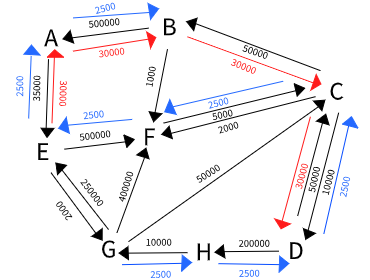
Illustration of the web-of-trust and payments in the simulation above (full size)
This is a multi-server Ripple. It is built on a penalty system that applies a force on the multi-hop payment coordination (see multihop.xyz for an interactive simulation). The penalty system advances on Ryan Fugger's original ideas from 2006 of a penalty as an enforcement mechanism.
Whitepaper: ripple_inter_server_protocol.pdf (and for an article with some images, see multi_hop_payment_game_theory.pdf)
Articles: incentivesystem.pdf, decisionmaking.pdf, multihop_rules.pdf, deter_DoS_attacks.pdf, denial_of_service.pdf, 3phase_commit.pdf, 3phase.pdf
Repository: bitbucket.org/bipedaljoe/ripple-normal (also on ripple.archi/code)
Versions: versions.html
Simulation: 8_users_payment_scenario.json
Simulation output: output.txt

Illustration of the web-of-trust and payments in the simulation above (full size)
News: 14/05/2025: Now built "rippleproxy", a HTTPS multi-user proxy that manages a users secret key and counter and interacts with Ripple Inter Server Protocol servers. Also a very basic "ripplebrowser" that is a web UI on top of "rippleproxy". bitbucket.org/bipedaljoe/ripplebrowser
Contact: johan@ripple.archi
Ripple papers by Ryan Fugger: 2003, 2004, 2006
Resilience swarm redistribution on ripple.archi: My system "Resilience" (swarm redistribution) has been added in full to a modified version of the platform. For links to repositories, see resilience.me/versions.html.